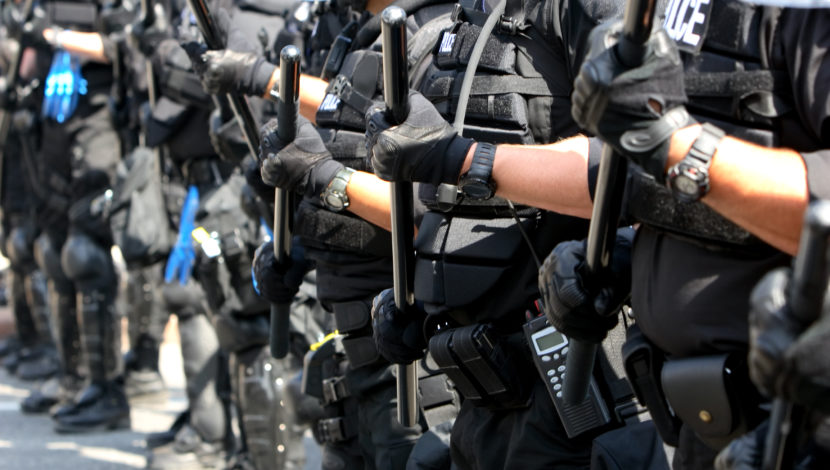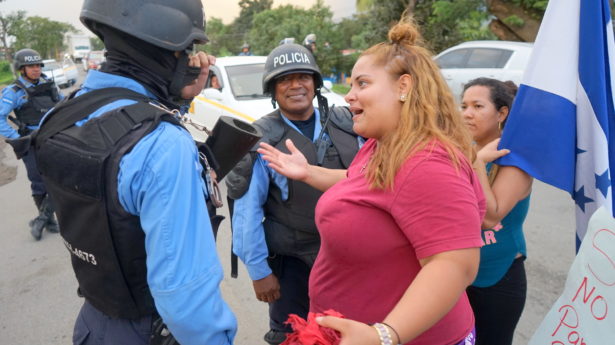The Unitarian Universalist Service Committee advances human rights through grassroots collaborations.
What’s Really Happening at the Border? Four Things to Know

By on November 28, 2018
The past few days brought a stream of disturbing reports from the U.S.-Mexico border. Over the weekend, news broke that the United States and Mexico had allegedly reached an agreement to hold asylum-seekers in Mexico while awaiting processing in the United States, potentially violating international law. Later, U.S. and Mexican officials gave conflicting accounts of whether such a plan, dubbed “Remain in Mexico,” had actually been approved.
Then, on Sunday, U.S. officials fired tear gas – a dangerous chemical agent – on asylum-seekers, including families and children, while they were trying to cross the U.S.-Mexico border. The Trump administration followed this incident by temporarily shutting down the San Ysidro port of entry – a crucial border crossing located between San Diego and Tijuana.
As in the past, the president has responded to these events with misinformation and hate. The Trump administration’s words and actions in recent weeks have set the preconditions for violence and undermined the internationally-protected right to seek asylum at every turn. What’s more, the president has sought to manipulate these events for political gain, hyping fears of a breakdown of “border security” to gain additional funds from Congress for the same militarization that resulted in this weekend’s violence.
The reality underlying Trump’s invented crisis hasn’t changed: people have a right to seek asylum from persecution across borders. As events unfold this week, here are four crucial facts to keep in mind.
1. Asylum-seekers have the legal right to enter the United States and request protection.
In recent weeks, the Trump administration has tried to force all asylum-seekers to make their claims only at official ports of entry (like the San Ysidro crossing). These efforts included an executive action attempting to deny asylum eligibility to anyone who crossed the border outside these areas – a move that was promptly struck down by the federal courts for directly contravening U.S. asylum law and the international treaty obligations that inform it.
Meanwhile, asylum processing at the ports of entry has slowed to a crawl due to a practice known as “metering,” which involves making asylum-seekers wait for available space in the port of entry holding zones before they can be processed. Advocates have reported that U.S. border officials are turning some asylum-seekers away even when capacity exists to process them.
The president’s efforts to make asylum inaccessible outside of ports of entry, as well as the slow processing of asylum claims at the ports, has left thousands of Central American asylum-seekers stranded in Tijuana. As a result, asylum-seekers protested this unjust treatment on Sunday and a few attempted to cross the border outside the port of entry, which they have the right to do under international law, if seeking asylum. U.S. Customs and Border Protection (CBP) agents responded by firing a chemical irritant – tear gas – which is inherently indiscriminate and was quickly blown into the faces of many other asylum-seekers, many of whom had made no attempt to cross the border.
By slowing the processing of asylum-seekers to a trickle and denying them entry to U.S. territory while their claims are processed, it is the United States government, not the exodus of asylum-seekers, that is breaking the law.
2. CBP’s response was entirely disproportionate and inflamed by Trump’s rhetoric.
The vast majority of asylum seekers protesting on Sunday, were doing so peacefully. While some reports claimed that a few asylum-seekers who attempted to cross the border threw rocks and other small objects, the response by U.S. authorities was in any case grossly disproportionate and indiscriminate, including the firing of tear gas on families and children. This is in keeping with U.S. Border Patrol’s long record of responding with excessive violence to unarmed migrants and asylum seekers who pose no threat to their safety.
Donald Trump’s rhetoric in recent weeks, including his calls for the U.S. military to consider rock-throwing as equivalent to carrying a firearm, fueled this disproportionate response. In the longer term, his words have likely contributed to a climate in which U.S. officials feel they can inflict violence on migrants and asylum-seekers with impunity.
3. The United States and Mexico have no authority to hold people in Mexico.
It is still not clear what form if any Trump’s “Remain in Mexico” policy may take, as U.S. and Mexican authorities continue to provide differing accounts of whether or not such an agreement is in place. In any event, the Mexican government does not have the authority to prevent people from leaving its territory. Human rights standards are clear that, “Everyone has the right to leave any country, including [their] own,” in the words of the Universal Declaration of Human Rights (UDHR).
The United States, meanwhile, does not have the right to turn people away from its territory without first offering the chance for a fair asylum screening, according to the United Nations High Commissioner for Refugees. This stems from one of the most fundamental principles undergirding international refugee law: that of not returning people to countries where they will face persecution. Nor is there anything in international law that obliges an asylum-seeker to apply for asylum in countries through which they are traveling. Mexico in particular is not a safe option for many people fleeing violence.
4. Trump’s actions follow the playbook of contemporary authoritarian regimes.
By blocking and criminalizing asylum-seekers outside official ports of entry and forcing everyone seeking protection to wait at a handful of border crossings, Trump’s actions mirror those of the current government in Hungary. As detailed in a recent UUSC report: “In 2015, Hungary built a 325-mile fence along its border with Serbia to keep asylum-seekers out of the country and made unauthorized entry across the fence grounds for immediate prosecution and deportation. As of March 2017, asylum applications could only be processed in ‘transit zones’ at the Hungarian border fence.”
Conditions quickly became deplorable in these “transit zones,” and Hungary moved to designate its neighbor Serbia a “safe third country,” in an effort to gain a pseudo-legal authority to return all asylum-seekers back across the border. According to UUSC’s partners in Hungary, these actions laid the groundwork for creeping authoritarianism, including a crack-down on civil society and human rights workers. Hungary has since become a case study in the rise of “arbitrary rule” in a formerly democratic society.
When the Trump administration moves to shut down access to the United States and slows asylum processing to a trickle, this is the vision with which they are aligned. The responsibility of the human rights movement now as in the past will be to insist on a different vision: one rooted in the recognition that people have the right to seek protection from persecution and injustice.
Photo credit: filo
Read This Next
Trump’s New Rule Strikes at the Heart of U.S. Asylum
Lives depend on a functioning, accessible asylum system Read More →
